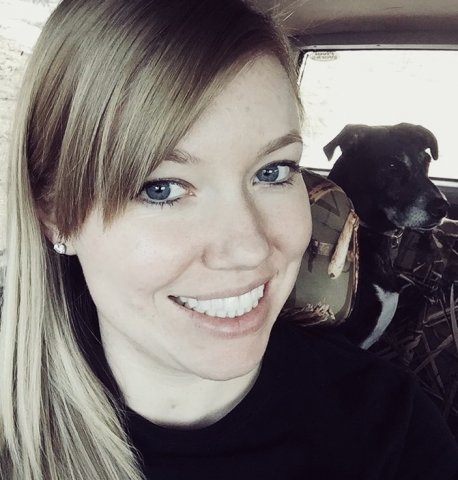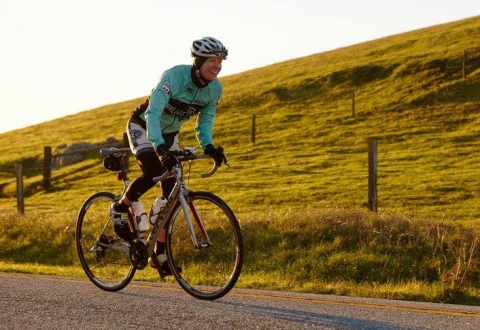
27-year old Katelyn Mathews has been dealing with chronic neck and shoulder pain for over a decade. While it began when
she was playing high school basketball, she was also diagnosed with psoriatic arthritis in her 20s. The pain was constant, exacerbated by a job that required a lot of computer time, and accompanied by headaches. Most nights she needed a heating pad to fall asleep.
Over the years, Katelyn had tried chiropractic, massage, trigger point injections, epidurals, and traditional physical therapy in search of relief. If she was lucky, the pain would lessen for a few days, but not much more.
Then she discovered dry needling and her life changed.
Katelyn was referred to Dr. Joel Peck, Doctor of Physical Therapy at Great Basin Orthopaedics who is certified in dry needling.
“After my first therapy session, I felt some relief,” she recounts, “After six sessions, I was almost pain free. It was the best I’d felt in years. Dry needling is the only thing that has ever worked for me.”
What is dry needling?
Dry needling is a therapeutic technique for treating persistent pain (also called myofascial pain) and muscle and joint dysfunction. It uses thin, stainless steel needles (without medication), which are inserted into the muscle. The needle structure itself induces the therapeutic effects, calming inflamed nerves and eliminating trigger points (muscles that aren’t working correctly due to the inflammation).
Dry needling or intramuscular manual therapy is used with the goal of: 1) alleviating pain, 2) restoring motion and function, and 3) inducing a healing response in the tissue, speeding up the recovery process.
According to Dr. Peck, almost any condition where physical therapy is prescribed has the potential to benefit from dry needling. From Achilles tendonitis to radiating back pain, carpal tunnel syndrome to pinched nerves in the neck, Dr. Peck has seen the beneficial outcomes of dry needling.
“Dry needling provides both a physical and physiological stress,” Dr. Peck explains. “It can effectively address soft tissue inflammation, sensitized nerve tissue, scar tissue formation and tissue adhesions, as well as deficiencies in blood and lymphatic circulation.”
Sometimes a therapist will direct an electric current into needles which are inserted in the skin, creating rhythmic vibration in the tissue. This vibration helps further reduce tension in scar tissue and restore lymphatic circulation.
How does dry needling work?
Dry needling succeeds with a two-fold approach:
- It calms inflamed nerves system-wide, and
- It addresses specific muscle dysfunction.
To calm nerves throughout the body, the therapist must first identify the nerve center to target, then insert a needle in the nerve emergence points which bring blood proteins to the area. To address the muscle dysfunction, the needles are inserted into the muscle nodules, adhesions, scar tissue, initiating a vascular response. In effect, the small hole left by the needle cylinder is replaced with healthy new tissue over a 24 to 48-hour period.
Is dry needling the same as acupuncture?
Although they use the same type of needles, dry needling is not the same as Chinese acupuncture, which is based on Chinese medicine and the concept of energy meridians throughout the body that affect health. Acupuncture needles are intended to disrupt meridian blockages, restore proper energy flow, or chi, and thereby resolve illness. Dry needling, on the other hand, induces both a vascular (blood flow) and neurogenic (nerve) response that desensitizes the inflamed nerves and regenerates tissue, thereby alleviating pain in the soft tissue and restoring mobility.
RELATED: Why physical therapy matters
When is dry needling warranted?
Dry needling is just one of the treatment options available to physical therapists to help alleviate persistent pain and dysfunction, and help return the patient to normal activity. Symptoms include:
- Deep, aching pain in a muscle
- Pain that persists or worsens
- A tender knot in a muscle
- Difficulty sleeping due to pain
A trained physical therapist like Dr. Peck will perform a thorough evaluation to determine if the patient is a good candidate for the treatment which is usually combined with other techniques. “I rarely use dry needling alone,” he explains. “It works best as part of a comprehensive approach that may include manual therapy, kinetic exercises and posture adjustments.”
Does dry needling work?
In addition to thousands of patient stories like Katelyn and Michelle’s, there is clinical research supporting the efficacy of dry needling. Back in 2010, The Journal of the American Board of Family Medicine, published aclinical narrative, indicating that dry needling reduces pain and muscle tension, and facilitates a return to function by normalizing the nerve impulses transmitted to the irritated muscles.
In a study published in the September 2013 issue of the Journal of Orthopaedic & Sports Physical Therapy, a group of researchers analyzed the results of the best clinical studies that had been conducted so far on dry needling. Reviewing the results of the relevant studies, the researchers determined that dry needling can be effective in providing pain relief. For those with chronic pain, the possibility of alleviating that pain without narcotics is a welcome option.
For Dr. Peck, dry needling has proven an invaluable tool in the physical therapy arsenal. “I have seen phenomenal outcomes with dry needling for patients who were not progressing with other treatments,” explains Dr. Peck. “It is an effective, minimally-invasive therapy that is typically pain-free to administer.”

Michelle Faurot, a competitive triathlete, was experiencing knee pain when her physical therapist recommended dry needling. Targeting scar tissue in her hamstrings and glutes that were referring pain to her knees, the dry needling session provided almost instant results, enabling her to run a triathlon pain-free a few weeks later.
Who can perform dry needling?
In the United States, approximately 20 states and the District of Columbia have approved dry needling by physical therapists. This is a dramatic increase from 2004 when only four states were approved. Nevada approved dry needling in 2012.
In addition to a background in anatomy, physiology and pain sciences, specific postgraduate training in dry needling is also required. Several institutions offer certification in dry needling.
RELATED: The Opioid Threat
If you’re struggling with chronic muscle or joint pain and looking for therapeutic options, make an appointment with Great Basin Orthopaedics. Working closely with Board Certified orthopaedists, Dr. Peck and his team have a host of tools, including dry needling, available to help alleviate pain and recover function and mobility in patients post injury and surgery.